In one month, a travelling salesman goes from Delhi to Kolkata that are 1484 km apart. From Kolkata he goes to Goa which is 2129 km away and returns to Delhi via Kolkata in the same month. The traveling salesman repeats this trip for 4 months. How many kilometres did the salesmann travel in 4 months?
The correct Answer is:28,904 km
To solve the problem step by step, we will calculate the total distance traveled by the salesman in one month and then multiply that by the number of months (4 months).
Step 1: Calculate the distance from Delhi to Kolkata
The distance from Delhi to Kolkata is given as:
- Distance (Delhi to Kolkata) = 1484 km
Step 2: Calculate the distance from Kolkata to Goa
The distance from Kolkata to Goa is given as:
- Distance (Kolkata to Goa) = 2129 km
Step 3: Calculate the total distance for one complete trip (Delhi to Kolkata to Goa and back to Delhi)
1. First, we need to add the distances from Delhi to Kolkata and Kolkata to Goa:
Total distance (one way)=1484 km+2129 km
=3613 km
2. Since the salesman returns to Delhi via Kolkata, we need to double this distance (to account for the return trip):
Total distance (round trip)=3613 km×2=7226 km
Step 4: Calculate the total distance for 4 months
Now, we multiply the distance of one complete trip by the number of months (4):
Total distance (4 months)=7226 km×4
Calculating this:
1. 4×6=24 (write down 4, carry over 2)
2. 4×2=8 plus the carry over 2 gives 10 (write down 0, carry over 1)
3. 4×2=8 plus the carry over 1 gives 9 (write down 9)
4. 4×7=28 (write down 28)
So, the total distance traveled in 4 months is:
Total distance=28904 km
Final Answer
Thus, the total distance traveled by the salesman in 4 months is 28904 km.
---
The distance from Delhi to Kolkata is given as:
- Distance (Delhi to Kolkata) = 1484 km
The distance from Kolkata to Goa is given as:
- Distance (Kolkata to Goa) = 2129 km
1. First, we need to add the distances from Delhi to Kolkata and Kolkata to Goa:
Total distance (one way)=1484 km+2129 km
=3613 km
Total distance (round trip)=3613 km×2=7226 km
Now, we multiply the distance of one complete trip by the number of months (4):
Total distance (4 months)=7226 km×4
Calculating this:
1. 4×6=24 (write down 4, carry over 2)
2. 4×2=8 plus the carry over 2 gives 10 (write down 0, carry over 1)
3. 4×2=8 plus the carry over 1 gives 9 (write down 9)
4. 4×7=28 (write down 28)
Total distance=28904 km
Thus, the total distance traveled by the salesman in 4 months is 28904 km.
Similar Questions
A boy starts from home, goes to a shop, which is 2 km away, buys things, and comes back in an hour. What is the speed with which he travels?
View SolutionThe given graph (Fig 15.8) describes the distances of a car from a city P at different times when it is travelling from City P to City Q, which are 350 km apart. Study the graph and answer the following:(i) What information is given on the two axes?(ii) From where and when did the car begin its journey?(iii) How far did the car go in the first hour?(iv) How far did the car go during (i) the 2nd hour? (ii) the 3rd hour?(v) Was the speed same during the first three hours? How do you know it?(vi) Did the car stop for some duration at any place? Justify your answer.(vii) When did the car reach City Q?
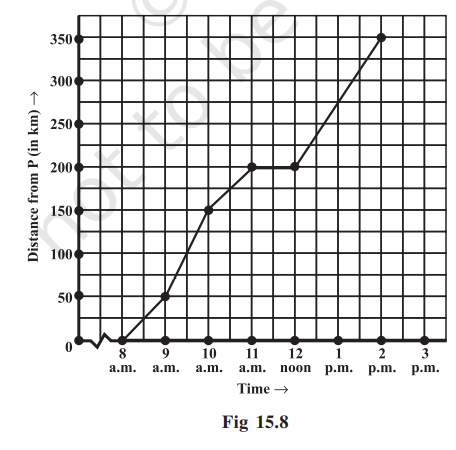 View Solution
View Solution
Knowledge Check
- Question 1 - Select One
Transforming the American West Through Food and Hospitality
Just as travelers taking road trips today may need to take a break for food at a rest area along the highway, settlers traversing the American West by train in the mid-1800s often found 12 themselves in need of refreshment. However, food available on rail lines was generally of terrible quality. 13 Despite having worked for railroad companies, Fred Harvey, an English-born 14 entrepreneur. He decided to open his own restaurant business to serve rail customers. Beginning in the 1870s, he opened dozens of restaurants in rail stations and dining cars. These Harvey Houses, which constituted the first restaurant chain in the United States, 15 was unique for its high standards of service and quality. The menu was modeled after those of fine restaurants, so the food was leagues beyond the 16 sinister fare travelers were accustomed to receiving in transit. His restaurants were immediately successful, but Harvey was not content to follow conventional business practices. 17 Although women did not traditionally work in restaurants in the nineteenth century, Harvey decided to try employing women as waitstaff. In 1883, he placed an advertisement seeking educated, well-mannered, articulate young women between the ages of 18 and 30. 18 Response to the advertisement was overwhelming, even tremendous, and Harvey soon replaced the male servers at his restaurants with women. Those who were hired as “Harvey Girls” joined an elite group of workers, who were expected to complete a 30-day training program and follow a strict code of rules for conduct and curfews. In the workplace, the women donned identical black-and-white uniforms and carried out their duties with precision. Not only were such regulations meant to ensure the efficiency of the business and the safety of the workers, 19 but also helped to raise people’s generally low opinion of the restaurant industry In return for the servers’ work, the position paid quite well for the time: $17.50 a month, plus tips, meals, room and board, laundry service, and travel expenses. 20 For as long as Harvey Houses served rail travelers through the mid-twentieth century, working there was a steady and lucrative position for women. Living independently and demonstrating an intense work 21 ethic, the Harvey Girls became known as a transformative force in the American 22 West. Advancing the roles of women in the restaurant industry and the American workforce as a whole, the Harvey Girls raised the standards for restaurants and blazed a trail in the fast-changing landscape of the western territories.
The writer is considering revising the underlined portion of the sentence to read:
West, inspiring books, documentaries, and even a musical.
Should the writer add this information here?AYes, because it provides examples of the Harvey Girls’ influence.BYes, because it serves as a transitional point in the paragraph.CNo, because it should be placed earlier in the passage.DNo, because it contradicts the main claim of the passage. - Question 2 - Select One
Transforming the American West Through Food and Hospitality
Just as travelers taking road trips today may need to take a break for food at a rest area along the highway, settlers traversing the American West by train in the mid-1800s often found 12 themselves in need of refreshment. However, food available on rail lines was generally of terrible quality. 13 Despite having worked for railroad companies, Fred Harvey, an English-born 14 entrepreneur. He decided to open his own restaurant business to serve rail customers. Beginning in the 1870s, he opened dozens of restaurants in rail stations and dining cars. These Harvey Houses, which constituted the first restaurant chain in the United States, 15 was unique for its high standards of service and quality. The menu was modeled after those of fine restaurants, so the food was leagues beyond the 16 sinister fare travelers were accustomed to receiving in transit. His restaurants were immediately successful, but Harvey was not content to follow conventional business practices. 17 Although women did not traditionally work in restaurants in the nineteenth century, Harvey decided to try employing women as waitstaff. In 1883, he placed an advertisement seeking educated, well-mannered, articulate young women between the ages of 18 and 30. 18 Response to the advertisement was overwhelming, even tremendous, and Harvey soon replaced the male servers at his restaurants with women. Those who were hired as “Harvey Girls” joined an elite group of workers, who were expected to complete a 30-day training program and follow a strict code of rules for conduct and curfews. In the workplace, the women donned identical black-and-white uniforms and carried out their duties with precision. Not only were such regulations meant to ensure the efficiency of the business and the safety of the workers, 19 but also helped to raise people’s generally low opinion of the restaurant industry In return for the servers’ work, the position paid quite well for the time: $17.50 a month, plus tips, meals, room and board, laundry service, and travel expenses. 20 For as long as Harvey Houses served rail travelers through the mid-twentieth century, working there was a steady and lucrative position for women. Living independently and demonstrating an intense work 21 ethic, the Harvey Girls became known as a transformative force in the American 22 West. Advancing the roles of women in the restaurant industry and the American workforce as a whole, the Harvey Girls raised the standards for restaurants and blazed a trail in the fast-changing landscape of the western territories.
The writer is considering deleting the previous sentence. Should the writer make this change?AYes, because it introduces information that is irrelevant at this point in the passage.BYes, because it does not logically follow from the previous paragraph.CNo, because it provides a logical introduction to the paragraph.DNo, because it provides a specific example in support of arguments made elsewhere in the passage. - Question 3 - Select One
Transforming the American West Through Food and Hospitality
Just as travelers taking road trips today may need to take a break for food at a rest area along the highway, settlers traversing the American West by train in the mid-1800s often found 12 themselves in need of refreshment. However, food available on rail lines was generally of terrible quality. 13 Despite having worked for railroad companies, Fred Harvey, an English-born 14 entrepreneur. He decided to open his own restaurant business to serve rail customers. Beginning in the 1870s, he opened dozens of restaurants in rail stations and dining cars. These Harvey Houses, which constituted the first restaurant chain in the United States, 15 was unique for its high standards of service and quality. The menu was modeled after those of fine restaurants, so the food was leagues beyond the 16 sinister fare travelers were accustomed to receiving in transit. His restaurants were immediately successful, but Harvey was not content to follow conventional business practices. 17 Although women did not traditionally work in restaurants in the nineteenth century, Harvey decided to try employing women as waitstaff. In 1883, he placed an advertisement seeking educated, well-mannered, articulate young women between the ages of 18 and 30. 18 Response to the advertisement was overwhelming, even tremendous, and Harvey soon replaced the male servers at his restaurants with women. Those who were hired as “Harvey Girls” joined an elite group of workers, who were expected to complete a 30-day training program and follow a strict code of rules for conduct and curfews. In the workplace, the women donned identical black-and-white uniforms and carried out their duties with precision. Not only were such regulations meant to ensure the efficiency of the business and the safety of the workers, 19 but also helped to raise people’s generally low opinion of the restaurant industry In return for the servers’ work, the position paid quite well for the time: $17.50 a month, plus tips, meals, room and board, laundry service, and travel expenses. 20 For as long as Harvey Houses served rail travelers through the mid-twentieth century, working there was a steady and lucrative position for women. Living independently and demonstrating an intense work 21 ethic, the Harvey Girls became known as a transformative force in the American 22 West. Advancing the roles of women in the restaurant industry and the American workforce as a whole, the Harvey Girls raised the standards for restaurants and blazed a trail in the fast-changing landscape of the western territories..
Which choice best maintains the tone established in the passage?ANO CHANGEBsurlyCabysmalDicky
How Do You Like Those Apples? Marketed as SmartFresh, the chemical 1-MCP (1-methylcyclopropene) has been used by fruit growers since 2002 in the United States and elsewhere to preserve the crispness and lengthen the storage life of apples and other fruit, which often must travel long distances before being eaten by consumers. 23 1-MCP lengthens storage life by three to four times when applied to apples. This extended life allows producers to sell their apples in the off-season, months after the apples have been harvested. And at a cost of about one cent per pound of apples, 1-MCP is a highly cost-effective treatment. However, 1-MCP is not a panacea for fruit producers or sellers: there are problems and limitations associated with its use.[1] 1-MCP works by limiting a fruit’s production of ethylene, 24 it is a chemical that causes fruit to ripen and eventually rot. [2] While 1-MCP keeps apples 25 tight and crisp for months, it also limits 26 their scent production. [3] This may not be much of a problem with certain kinds of apples that are not naturally very fragrant, such as Granny Smith, but for apples that are prized for their fruity fragrance, such as McIntosh, this can be a problem with onsumers, 27 that will reject apples lacking the expected aroma. [4] But some fruits do not respond as well to 1-MCP as others 28 did, and some even respond adversely. [5] Furthermore, some fruits, particularly those that naturally produce a large amount of ethylene, do not respond as well to 1-MCP treatment. [6] Take Bartlett 29 pears, for instance, unless they are treated with exactly the right amount of 1-MCP at exactly the right time, they will remain hard and green until they rot, and consumers who experience this will be unlikely to purchase them again. 30 Finally, researchers have found that 1-MCP actually increases susceptibility to some pathologies in certain apple varieties. For example, Empire apples are prone to a condition that causes the flesh of the apple to turn brown. Traditionally, apple producers have dealt with this problem by leaving the apples in the open air for three weeks before storing them in a controlled atmosphere with tightly regulated temperature, humidity, and carbon dioxide levels. As the graph shows, the flesh of untreated Empire apples that are first stored in the open air undergoes 31 roughly five percent less browning than the flesh of untreated Empire apples that are immediately put into storage in a controlled environment. However, when Empire apples are treated with 1-MCP, 32 their flesh turns brown when the apples are first stored in the open air, though not under other conditions. Although researchers continue to search for the right combination of factors that will keep fruits fresh and attractive, 33 the problem may be that consumers are overly concerned with superficial qualities rather than the actual freshness of the fruit.
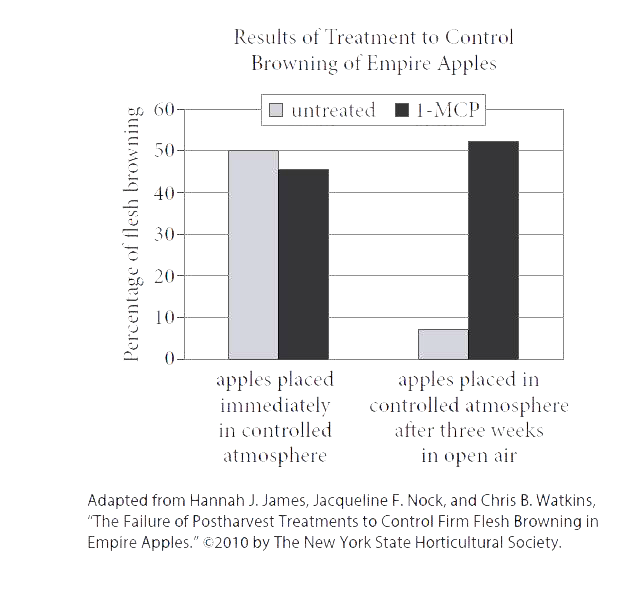
Which choice most effectively combines the underlined sentences?View SolutionHow Do You Like Those Apples? Marketed as SmartFresh, the chemical 1-MCP (1-methylcyclopropene) has been used by fruit growers since 2002 in the United States and elsewhere to preserve the crispness and lengthen the storage life of apples and other fruit, which often must travel long distances before being eaten by consumers. 23 1-MCP lengthens storage life by three to four times when applied to apples. This extended life allows producers to sell their apples in the off-season, months after the apples have been harvested. And at a cost of about one cent per pound of apples, 1-MCP is a highly cost-effective treatment. However, 1-MCP is not a panacea for fruit producers or sellers: there are problems and limitations associated with its use.[1] 1-MCP works by limiting a fruit’s production of ethylene, 24 it is a chemical that causes fruit to ripen and eventually rot. [2] While 1-MCP keeps apples 25 tight and crisp for months, it also limits 26 their scent production. [3] This may not be much of a problem with certain kinds of apples that are not naturally very fragrant, such as Granny Smith, but for apples that are prized for their fruity fragrance, such as McIntosh, this can be a problem with consumers, 27 that will reject apples lacking the expected aroma. [4] But some fruits do not respond as well to 1-MCP as others 28 did, and some even respond adversely. [5] Furthermore, some fruits, particularly those that naturally produce a large amount of ethylene, do not respond as well to 1-MCP treatment. [6] Take Bartlett 29 pears, for instance, unless they are treated with exactly the right amount of 1-MCP at exactly the right time, they will remain hard and green until they rot, and consumers who experience this will be unlikely to purchase them again. 30 Finally, researchers have found that 1-MCP actually increases susceptibility to some pathologies in certain apple varieties. For example, Empire apples are prone to a condition that causes the flesh of the apple to turn brown. Traditionally, apple producers have dealt with this problem by leaving the apples in the open air for three weeks before storing them in a controlled atmosphere with tightly regulated temperature, humidity, and carbon dioxide levels. As the graph shows, the flesh of untreated Empire apples that are first stored in the open air undergoes 31 roughly five percent less browning than the flesh of untreated Empire apples that are immediately put into storage in a controlled environment. However, when Empire apples are treated with 1-MCP, 32 their flesh turns brown when the apples are first stored in the open air, though not under other conditions. Although researchers continue to search for the right combination of factors that will keep fruits fresh and attractive, 33 the problem may be that consumers are overly concerned with superficial qualities rather than the actual freshness of the fruit.
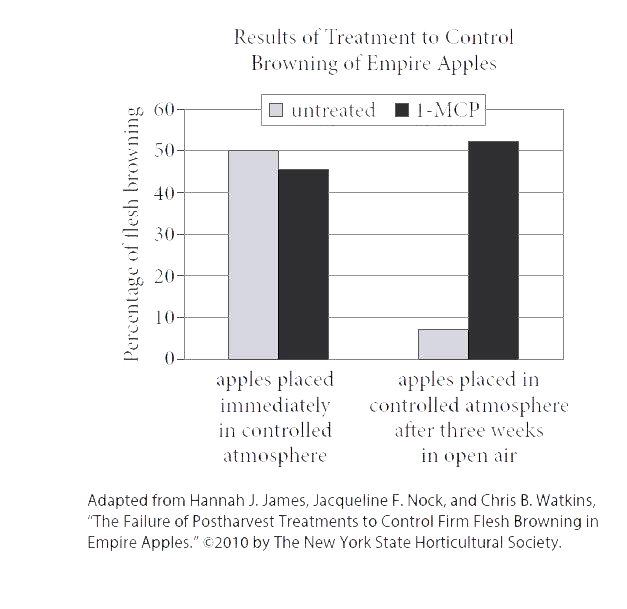 View Solution
View SolutionHow Do You Like Those Apples? Marketed as SmartFresh, the chemical 1-MCP (1-methylcyclopropene) has been used by fruit growers since 2002 in the United States and elsewhere to preserve the crispness and lengthen the storage life of apples and other fruit, which often must travel long distances before being eaten by consumers. 23 1-MCP lengthens storage life by three to four times when applied to apples. This extended life allows producers to sell their apples in the off-season, months after the apples have been harvested. And at a cost of about one cent per pound of apples, 1-MCP is a highly cost-effective treatment. However, 1-MCP is not a panacea for fruit producers or sellers: there are problems and limitations associated with its use.[1] 1-MCP works by limiting a fruit’s production of ethylene, 24 it is a chemical that causes fruit to ripen and eventually rot. [2] While 1-MCP keeps apples 25 tight and crisp for months, it also limits 26 their scent production. [3] This may not be much of a problem with certain kinds of apples that are not naturally very fragrant, such as Granny Smith, but for apples that are prized for their fruity fragrance, such as McIntosh, this can be a problem with consumers, 27 that will reject apples lacking the expected aroma. [4] But some fruits do not respond as well to 1-MCP as others 28 did, and some even respond adversely. [5] Furthermore, some fruits, particularly those that naturally produce a large amount of ethylene, do not respond as well to 1-MCP treatment. [6] Take Bartlett 29 pears, for instance, unless they are treated with exactly the right amount of 1-MCP at exactly the right time, they will remain hard and green until they rot, and consumers who experience this will be unlikely to purchase them again. 30 Finally, researchers have found that 1-MCP actually increases susceptibility to some pathologies in certain apple varieties. For example, Empire apples are prone to a condition that causes the flesh of the apple to turn brown. Traditionally, apple producers have dealt with this problem by leaving the apples in the open air for three weeks before storing them in a controlled atmosphere with tightly regulated temperature, humidity, and carbon dioxide levels. As the graph shows, the flesh of untreated Empire apples that are first stored in the open air undergoes 31 roughly five percent less browning than the flesh of untreated Empire apples that are immediately put into storage in a controlled environment. However, when Empire apples are treated with 1-MCP, 32 their flesh turns brown when the apples are first stored in the open air, though not under other conditions. Although researchers continue to search for the right combination of factors that will keep fruits fresh and attractive, 33 the problem may be that consumers are overly concerned with superficial qualities rather than the actual freshness of the fruit.
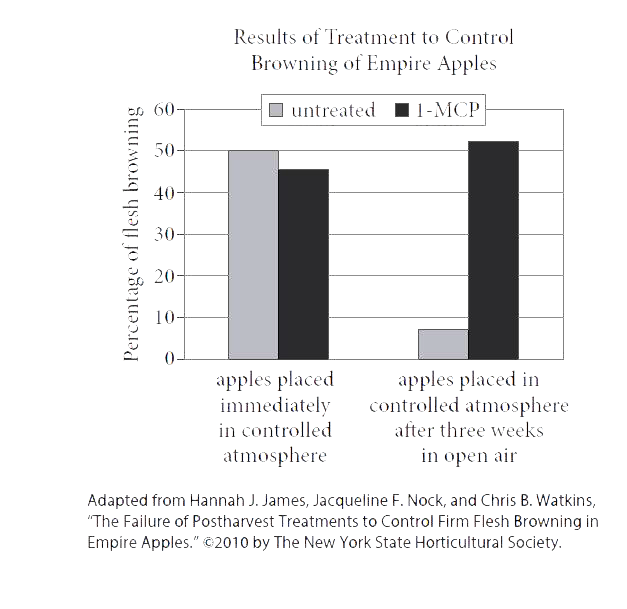
Which choice offers an accurate interpretation of the data in the graph?View SolutionHow Do You Like Those Apples? Marketed as SmartFresh, the chemical 1-MCP (1-methylcyclopropene) has been used by fruit growers since 2002 in the United States and elsewhere to preserve the crispness and lengthen the storage life of apples and other fruit, which often must travel long distances before being eaten by consumers. 23 1-MCP lengthens storage life by three to four times when applied to apples. This extended life allows producers to sell their apples in the off-season, months after the apples have been harvested. And at a cost of about one cent per pound of apples, 1-MCP is a highly cost-effective treatment. However, 1-MCP is not a panacea for fruit producers or sellers: there are problems and limitations associated with its use.[1] 1-MCP works by limiting a fruit’s production of ethylene, 24 it is a chemical that causes fruit to ripen and eventually rot. [2] While 1-MCP keeps apples 25 tight and crisp for months, it also limits 26 their scent production. [3] This may not be much of a problem with certain kinds of apples that are not naturally very fragrant, such as Granny Smith, but for apples that are prized for their fruity fragrance, such as McIntosh, this can be a problem with consumers, 27 that will reject apples lacking the expected aroma. [4] But some fruits do not respond as well to 1-MCP as others 28 did, and some even respond adversely. [5] Furthermore, some fruits, particularly those that naturally produce a large amount of ethylene, do not respond as well to 1-MCP treatment. [6] Take Bartlett 29 pears, for instance, unless they are treated with exactly the right amount of 1-MCP at exactly the right time, they will remain hard and green until they rot, and consumers who experience this will be unlikely to purchase them again. 30 Finally, researchers have found that 1-MCP actually increases susceptibility to some pathologies in certain apple varieties. For example, Empire apples are prone to a condition that causes the flesh of the apple to turn brown. Traditionally, apple producers have dealt with this problem by leaving the apples in the open air for three weeks before storing them in a controlled atmosphere with tightly regulated temperature, humidity, and carbon dioxide levels. As the graph shows, the flesh of untreated Empire apples that are first stored in the open air undergoes 31 roughly five percent less browning than the flesh of untreated Empire apples that are immediately put into storage in a controlled environment. However, when Empire apples are treated with 1-MCP, 32 their flesh turns brown when the apples are first stored in the open air, though not under other conditions. Although researchers continue to search for the right combination of factors that will keep fruits fresh and attractive, 33 the problem may be that consumers are overly concerned with superficial qualities rather than the actual freshness of the fruit.
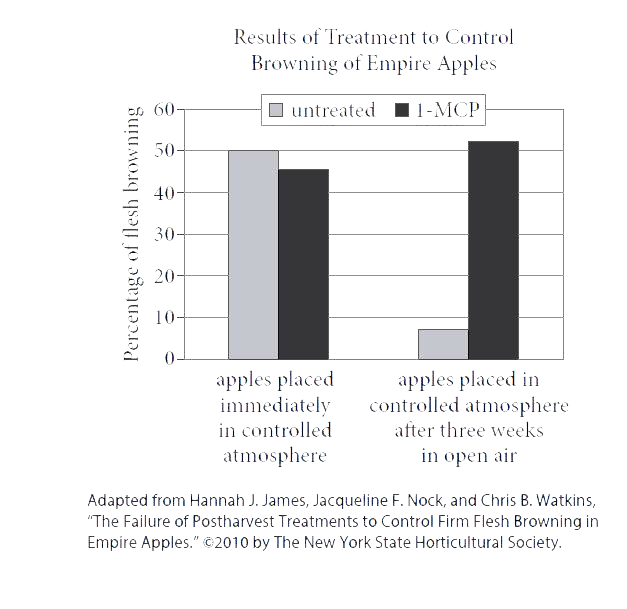
To make this paragraph most logical sentcence 4 should be placedView SolutionHow Do You Like Those Apples? Marketed as SmartFresh, the chemical 1-MCP (1-methylcyclopropene) has been used by fruit growers since 2002 in the United States and elsewhere to preserve the crispness and lengthen the storage life of apples and other fruit, which often must travel long distances before being eaten by consumers. 23 1-MCP lengthens storage life by three to four times when applied to apples. This extended life allows producers to sell their apples in the off-season, months after the apples have been harvested. And at a cost of about one cent per pound of apples, 1-MCP is a highly cost-effective treatment. However, 1-MCP is not a panacea for fruit producers or sellers: there are problems and limitations associated with its use.[1] 1-MCP works by limiting a fruit’s production of ethylene, 24 it is a chemical that causes fruit to ripen and eventually rot. [2] While 1-MCP keeps apples 25 tight and crisp for months, it also limits 26 their scent production. [3] This may not be much of a problem with certain kinds of apples that are not naturally very fragrant, such as Granny Smith, but for apples that are prized for their fruity fragrance, such as McIntosh, this can be a problem with consumers, 27 that will reject apples lacking the expected aroma. [4] But some fruits do not respond as well to 1-MCP as others 28 did, and some even respond adversely. [5] Furthermore, some fruits, particularly those that naturally produce a large amount of ethylene, do not respond as well to 1-MCP treatment. [6] Take Bartlett 29 pears, for instance, unless they are treated with exactly the right amount of 1-MCP at exactly the right time, they will remain hard and green until they rot, and consumers who experience this will be unlikely to purchase them again. 30 Finally, researchers have found that 1-MCP actually increases susceptibility to some pathologies in certain apple varieties. For example, Empire apples are prone to a condition that causes the flesh of the apple to turn brown. Traditionally, apple producers have dealt with this problem by leaving the apples in the open air for three weeks before storing them in a controlled atmosphere with tightly regulated temperature, humidity, and carbon dioxide levels. As the graph shows, the flesh of untreated Empire apples that are first stored in the open air undergoes 31 roughly five percent less browning than the flesh of untreated Empire apples that are immediately put into storage in a controlled environment. However, when Empire apples are treated with 1-MCP, 32 their flesh turns brown when the apples are first stored in the open air, though not under other conditions. Although researchers continue to search for the right combination of factors that will keep fruits fresh and attractive, 33 the problem may be that consumers are overly concerned with superficial qualities rather than the actual freshness of the fruit.

Which choice offers an accurate interpretation of the data in the graph?View Solution

